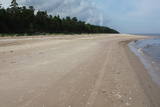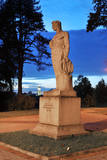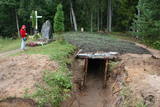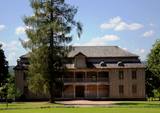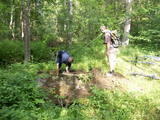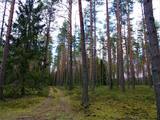| Nr | Nosaukums | Apraksts |
|---|---|---|
|
1869. g., dažus gadus pēc Ainažu jūrskolas dibināšanas, Ģipkā tika dibināta pirmā jūrskola Kurzemē. Šī bija 2. kategorijas jūrskola, kurā sagatavoja tālbraucējus stūrmaņus un tuvbraucējus kapteiņus. 1894. g. jūrskolu pārcēla uz Mazirbi. Pirms jūrskolas atvēršanās šajā ēkā no 1860. g. darbojās skola, bet 1867. g. speciāli jūrskolai, ēkai tika uzcelts otrais stāvs. Tā ir saglabājusies līdz pat mūsdienām un pārveidota par dzīvojamo māju. Skola (Ģipkā un Mazirbē) savas pastāvēšanas 28 gados devusi vairāk kā 200 profesionālu jūrnieku un tai bija liela nozīme kuģu būves veicināšanā piekrastes lībiešu ciemos. (Avots: Rojas TIC) |
||
|
Ja jums patīk aktīvs dzīvesveids, šī ekskursija ir ideāls veids, kā izbaudīt kulināro mantojumu, kas slēpjas Gaujas Nacionālajā parkā. Velomaršruts sākas no Strenčiem un vispirms ved caur divām vietējām alus darītavām Brenguļos un Valmiermuižā ar jaukām kafejnīcām un labu alu. Ceļā uz Valmieru apstāsieties arī Trikātas ciematā, lai nobaudītu vietēji gatavoto šokolādi. No Valmieras maršruts ved cauri skaistam mežam uz Cēsīm un tur esošo burvīgo viduslaiku vecpilsētu. Cēsīs apmeklēsiet vietējo maiznīcu un spirta rūpnīcu, lai nobaudītu produkciju. Jūs redzēsiet arī to, kā viduslaikos izskatījās ārstniecības un garšaugu dārzs. Brauksiet ar kanoe no Cēsīm uz Līgatni, kas ir viena no Gaujas skaistākajām vietām ar tās smilšakmens krastiem, attālām lauku viensētām un vecmodīgu ūdensdarbināmu prāmi. Līgatnes pilsētas vēsturiskais centrs ir saistīts ar tās papīrfabrikas attīstību. Šeit iespējams apmeklēt arī vietējos vīna un rokdarbu ražotājus vienā no apgabalam raksturīgajām mākslīgajām alām. Pārvietojoties pa kalnainajiem, līkumotajiem Siguldas ceļiem, redzēsiet Turaidas un Siguldas viduslaiku pilis, Gūtmaņala alu un citus gleznainus skatus. Siguldā baudīsiet latviešu tradicionālos ēdienus restorānos “Bucefāls”, “Aparjods” un viesu namā “Mauriņi” nobaudīsiet 80 ievārījumu veidus. |
||
|
Atrodas Rucavas galvenās ielas malā, netālu no centra.Rucavas draudzi dibināja 1871. gadā, bet izmēros nelielo dievnamu uzcēla 1888. gadā. |
||
|
Saimniecība audzē dažādus dārzeņus, lapu salātus, gurķus, dilles, ķiplokus, brokoļus, ziedkāpostus, sīpolus, ķirbjus, bietes utml. Vasarā un rudenī pieejamas avenes. Pārdošanā svaigi dārzeņi un augļi. |
||
|
Vidzemes skaistākās upes ieteka. Piekrastes posmā starp Gaujas un Daugavas ietekām atrodas viens no lielākajiem Latvijas kāpu kompleksiem ar izteiktām paraboliskām kāpām, kas apaugušas ar mežu (mežainas jūrmalas kāpas). Šī iemesla dēļ šī ir populāra Rīgas un Saulkrastu apkaimes atpūtas (rekreatīvā nozīme) teritorija. Atrodas Piejūras dabas parkā. |
||
|
Amatnieku biedrībā apvienojušies 65 Rūjienas un tās apkārtnes amatnieki. Piedāvā maizes cepšanu, ievārījuma vārīšanu, siera siešanas, rotu taisīšanu, ādas izstrādājumu, tamborēšanas un kulinārijas meistarklases. Piedāvā arī ,,Ražots Rūjienā" degustācijas (maize, kūpinājumi, kulinārijas izstrādājumi, ievārījumi, svaigas sulas, ķirbju produkcija, sezonas ogas un augļi, katrā sezonā citi ēdieni) un iepirkšanos. |
||
|
Tēlnieka Kārļa Zemdegas veidotais, 1939. gadā uzstādītais piemineklis veltīts Latvijas brīvvalsts zemkopības ministram Arturam Alberingam. Pieminekļa veidolā ir attēlots jauneklis ar sētuvi. Padomju laikā piemineklis pazuda un tā vietā novietoja ģipša pionieri. 1977. g. bērni atrod zemē ieraktās „Sējēja” daļas, bet 10 gadus vēlāk – Rūjas upē – tā galvu. Tagad atjaunotais „Sējējs” apskatāms vēsturiskajā vietā – Ternejas parkā pie Rīgas ielas. |
||
|
1948. gada oktobrī pret padomju varu noskaņotie nacionālie partizāni Īles mežos izveidoja 9 x 6 m lielu bunkuru, lai cīnītos pret pastāvošo iekārtu un ideoloģiju. Piecus mēnešus vēlāk Valsts drošības komiteja devās uzbrukumā minētajam bunkuram kā rezultātā pēc piecu stundu ilgas cīņas 15 partizāni gāja bojā, bet 9 saņēma gūstā. Lai atcerētos šo vēstures notikumu, Īles bunkurs ir atjaunots un brīvi pieejams ikvienam interesentam.
|
||
|
Mājas restorāns mājīgā, autentiskā lauku vidē, kur tiek pasniegti lauku ēdieni, uz galda celtas svaigas jūras veltes, kuras atceļojušas no Francijas, Spānijas vai Norvēģijas, kā arī vietējās, pašu saimnieku kūpinātas zivis. Ēdienkarte tiek radīta katru dienu no jauna, kas ikdienā ļauj piedāvāt svaigus produktus.
|
||
|
Raunas pilsdrupās (pils celtniecību uzsāka 1262. g un tā bija viena no galvenajām arhibīskapa rezidencēm) mūsdienās izveidots skatu tornis, no kura redzami iespaidīgie pils mūri, kādreizējā viduslaiku pilsētas vieta un Raunas centrs. Pils tornī ierīkota elektroniskā atslēga – lai iekļūtu tornī, jāpiespiež poga blakus torņa durvīm. Skatu torņa darba laiks 7:00 – 19:00. Pilsdrupas un apkārtni iespējams apskatīt jebkurā laikā. |
||
|
Taka iepazīstina ar Rīgas teritorijā esošo dabas lieguma zonu, kas veidota jūras piekrastes biotopu (meži, pļavas, niedrāji, kāpas) un Daugavgrīvas pļavās dzīvojošo putnu aizsardzībai. Daugavgrīva labi pārskatāma no putnu vērošanas torņa, kas pielāgots cilvēkiem ar īpašām vajadzībām. |
||
|
Atrodas Rucavas – Bārtas ceļa malā (pagrieziens uz Bārtas Romas katoļu baznīcu). Veltīts melioratoram Arvīdam Manfeldam – bijušā Liepājas rajona meliorācijas uzņēmuma priekšniekam kā pateicība no vietējiem iedzīvotājiem par ceļiem un tiltiem. |
||
|
Kempings atrodas Rīga-Ventspils šosejas 139. kilometrā, Tīrukšezera krastā. Piedāvā 3 labiekārtotas mājiņas ar WC un dušu. TV un kamīns koplietošanas telpās. Bārs, telšu vietas, laivu īre, makšķerēšanas iespējas, peldvieta, piknika vietas. Bērnu rotaļu dārzs un sporta laukums. Iespēja pasūtīt ēdināšanu. Telpas svinībām (20 personas). Galdu klāšana svinībām, darījumu pasākumiem visa gada garumā. |
||
|
Atrodas Viļānu dienviddaļā, Maltas upītes krastos, kuras tecējumu pārtrauc Viļānu HES. Par muižu atrodamas ziņas jau no 15. gs. beigām, kad tā piederēja bruņiniekam J. Loem. Līdzīgi kā Vidsmuiža, arī šī bija viena no Latgales lielākajām muižām, kurai piederēja zemes > 49 000 ha platībā. 18. - 19. gs. mijā ap muižu sāka veidoties Viļānu miests. Muižas dzīvojamo ēku, kas apskatāma tikai no ārpuses, ieskauj parks. |
||
|
Ceļa, kas ved uz jūru – galā, redzami Latvijas piekrastei samērā reti skati. Ja palaimējas, šeit var novērot vietējos zvejniekus darbībā, kas joprojām iet zvejā. Krasta kāpās aplūkojamas vecas, pamestas un arī sagrieztas zvejas liellaivas un dažādi mūsdienu zvejniecībā izmantojami „darba rīki”. |
||
|
Z/s “Rūķīšu tēja” ir viens no lielākajiem ārstniecības augu ražotājiem Latvijā. Uzņēmums produkcijas kvalitāti nodrošina, audzējot un ievācot augus savā saimniecībā un veicot rūpīgu žāvēšanas, uzglabāšanas un fasēšanas procesu. Ražošanas procesā netiek izmantoti aromatizatori, krāsvielas, konservanti un biezinātāji. Grupu ekskursijām neizpaliek arī gardo tēju degustācija un tēju izvēles ieteikumi. Interesantiem ir iespēja arī iegādāties produkciju ražotnes veikaliņā par iepriecinošām cenām. Saimniecībā audzē plašu augu klāstu, no kuriem gatavo tējas - kumelītes, piparmētru, raudeni, klinģerītes, asinszāles, baldriānu, ehināciju, kaķumētru, kaķpēdiņas, mārsilus, melisas, sirdsmāteri, vērmeli u.c augus. Šeit ir īpaši vērts iegriezties tad, kad augi zied un katrs no lauciņiem krāsojas savā, tikai tam raksturīgā tonī. |
||
|
Kurtuvenu muižas vietu apjož sens ģeometriski – ainaviski plānots parks. 19.gs. otrajā pusē tas bija ainaviskuma stilā ar dažādiem ģeometriskā parka elementiem. 4.2 ha lielajā parkā turpina ziedēt senās liepas, kļavas, oši, ozoli, citi dekoratīvie koki un krūmi – kopā vairāk nekā 20 šķirņu pārkoksnējušies augi.
|
||
|
Tikai zinātājs
vai arī cītīgs meklētājs šodien mežā starp
Meža māju un Ķemeru viesnīcu atradīs
kādreiz slavenā un nu jau bijušā sēravota
izplūdes vietu, kuru atpazīs pēc laika zoba un
cilvēku bojātajām dzelzsbetona konstrukcijām.
|
||
|
Krogs "Aitiņlauvas" atrodas Rīgas - Liepājas autoceļa (A 9) 22. kilometrā. Kroga „rozīnīte” ir ēdieni, kas gatavoti no meža veltēm. Interjers veltīts medniecības tematikai. Blakus izvietots aploks ar dambriežiem. Latviešu virtuve: buka cepetis, mežacūkas cepetis, brieža šķiņķa steiks, jēra cepetis, pildīta strauta forele. |
||
|
Ķekavas novada Daugmales pagastā atrodas pastaigām un dabas baudīšanai piemērots mežs, kurā baudīt dabas daudzveidību. |
||
